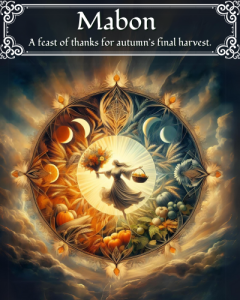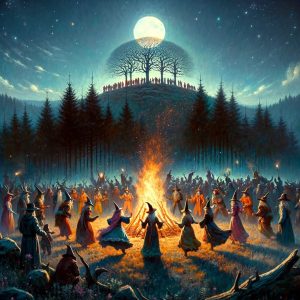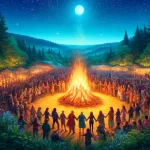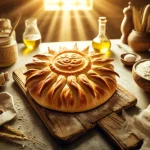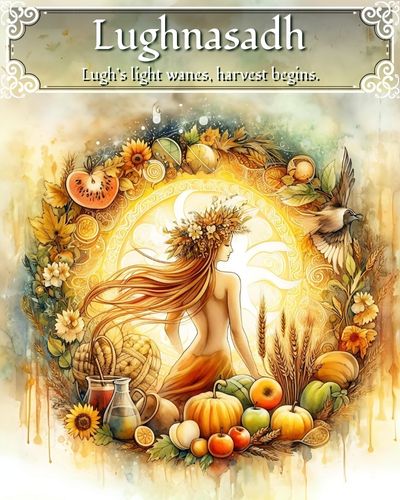
Approx. Reading time: About 31 Minutes

Introduction
Autumnal Equinox
As the wheel of the year turns, ushering in the bountiful autumn season, Pagans and nature enthusiasts alike come together to celebrate Mabon, a festival of balance, gratitude, and the second harvest. This ancient and meaningful observance holds a special place in the Pagan calendar, marking the autumnal equinox and embodying the harmonious dance between light and darkness, life, and death. The autumnal equinox is around September 21st in the northern hemisphere and around March 21st in the southern hemisphere. In this comprehensive article, we delve into the origins, traditions, modern practices, and significance of Mabon.

Origins and Historical Significance of Mabon
Mabon, often referred to as the Autumn Equinox, is a meaningful and ancient festival that holds its roots in various cultural and mythological traditions. This celebration marks a pivotal moment in the changing seasons and has been observed by different cultures throughout history, each attributing unique significance to this time of year.
The origins of Mabon can be traced back to the Celtic and Druidic traditions of the British Isles. The festival derives its name from the Welsh god Mabon ap Modron, a figure associated with youth, light, and the harvest. In Celtic mythology, Mabon is often connected to the tale of Culhwch and his quest to rescue Mabon ap Modron from captivity. This narrative symbolizes the transition from the abundance of summer to the waning of the light as autumn approaches. The story emphasizes the importance of unity and cooperation, themes that align with the changing dynamics of the seasons.
Mabon’s significance is not limited to Celtic mythology; it is also rooted in the astronomical phenomenon of the equinox. During the equinox, day and night are of nearly equal duration, highlighting the delicate balance between light and darkness. This balance is reflected in the shifting energies of nature and the acknowledgment of the interplay between opposing forces. In various cultures, this equilibrium has been associated with themes of harmony, gratitude, and reflection.
The historical importance of Mabon as a harvest festival cannot be overstated. In agrarian societies, the autumn equinox marked the culmination of the growing season, as crops were gathered from the fields. The harvest represented a time of abundance and plenty, and communities would come together to celebrate the fruits of their labor. Feasting, sharing of food, and offering thanks for the bountiful yield were central components of these celebrations.
Modern Interpretations
While Mabon has ancient origins, it continues to hold relevance in modern times. Many contemporary Pagans and Wiccans observe Mabon as a time of gratitude for the blessings of the year and a moment to reflect on the cyclical nature of life. Rituals may involve acknowledging the changing seasons, expressing thanks for the harvest, and connecting with the rhythms of nature. The origins and historical significance of Mabon encompass a rich tapestry of cultural, mythological, and astronomical influences. This festival, with its roots in Celtic and Druidic traditions, continues to be celebrated and honored in diverse ways, uniting people in their appreciation for the changing seasons, the balance between light and darkness, and the abundant gifts of the earth.
Traditions and Customs
Mabon is a time of giving thanks to the fruits of the land and the abundance of nature. Many of its traditions and customs are centered around gratitude and the recognition of the interconnectedness between humans and the natural world.
The Harvest Feast
Central to the festivities of Mabon is the time-honored tradition of the Harvest Feast. This cherished practice brings together friends, families, and communities to revel in the abundance of the season and give thanks for the earth’s generous offerings. As the leaves change color and the air turns crisp, the Harvest Feast becomes a symbolic gathering that embodies the essence of gratitude and unity.
During the Harvest Feast, tables are adorned with an array of culinary delights that reflect the bountiful harvest. Traditional foods take center stage, showcasing the richness of the season’s produce. Grains such as wheat, barley, and corn find their way into hearty dishes that pay homage to the hard work of farmers and the fertility of the land. Root vegetables, including carrots, potatoes, and squash, grace the feast with their earthy flavors, symbolizing the connection to the soil and the nurturing qualities of the earth. Apples, with their symbolism of wisdom and the cycle of life, often make an appearance, both as ingredients in dishes and as decorative elements. Nuts and berries, gathered from the wild or cultivated with care, provide a burst of flavor and a reminder of the natural abundance that surrounds us. These foods not only satiate the body but also serve as a reminder of the interconnectedness between humans and the earth.
The act of sharing a communal meal during Mabon is steeped in symbolism that goes beyond the mere enjoyment of food. It serves as a reminder of the importance of coming together, fostering a sense of unity, and strengthening the bonds of community. The act of breaking bread with loved ones and neighbors’ nurtures relationships and encourages a collective appreciation for the harvest’s rewards.
Moreover, the Harvest Feast is an opportunity for introspection and gratitude. As individuals gather around the table, they take a moment to reflect on the cycles of nature, the fruits of their labor, and the blessings that have been bestowed upon them. It is a time to express thanks for sustenance, warmth, and the beauty of the changing world around them.
Embarking on Enchanted Nature Walks
One of the most cherished traditions of Mabon is the practice of taking enchanting nature walks that immerse individuals in the captivating beauty of the changing season. As the air turns crisper and the leaves transform into a kaleidoscope of warm hues, these leisurely strolls become a deeply meaningful and magical experience. Guided by the whispers of the wind and the rustling of fallen leaves, nature walks during Mabon offer a profound connection to the natural world and its rhythmic cycles.
Amidst the vibrant tapestry of autumn, nature walks become a front-row seat to the breathtaking dance of change. Each step through forests, parks, or gardens unveils the exquisite transformation occurring all around. The lush greens of summer give way to the fiery reds, oranges, and golds of fall, painting the landscape in a symphony of colors. It’s a mesmerizing spectacle, a reminder that just as the seasons shift, so do the seasons of our lives.
Nature walks during Mabon are a feast for the senses, offering a multi-sensory experience that nurtures the spirit. The sound of crunching leaves beneath your feet creates a soothing rhythm, while the aroma of earth and decaying foliage mingles with the brisk air. The touch of cool breezes on your skin and the sight of dew-kissed spiderwebs glistening in the morning light evoke a sense of wonder and connectedness. As you walk, you may encounter woodland creatures preparing for the coming winter, a reminder of the delicate balance between survival and the cycle of life.
While nature walks provide an opportunity to appreciate the external beauty of the changing season, they also invite introspection and inner renewal. The tranquility of nature allows for quiet contemplation, a time to reflect on the passage of time, the lessons of the past, and the intentions for the future. The rustling leaves serve as a gentle reminder to release what no longer serves us, just as the trees let go of their foliage. With each step, the meditative rhythm of walking becomes a moving meditation, aligning the mind, body, and spirit.
As you meander along forest paths or through meadows, consider gathering some of nature’s treasures to bring a piece of the outdoors into your sacred space. Fallen leaves, acorns, pinecones, and twigs can be transformed into beautiful altar decorations or incorporated into crafts that honor the season’s spirit. By collecting these gifts, you establish a tangible connection to the land and the energies that flow through it.
Nature walks during Mabon become a form of harvest in themselves—a gathering of memories etched into the heart. The sights, sounds, and sensations encountered on these walks become a cherished tapestry woven into the fabric of one’s personal journey. As the years go by, revisiting the memories of these walks can evoke a sense of nostalgia and gratitude for the moments of connection, reflection, and inspiration they’ve provided.
In essence, embarking on nature walks during Mabon is a ritual of communion with the natural world and a celebration of the season’s splendor. These walks offer a space for both external observation and internal reflection, a harmonious blend of witnessing the world’s transformation and connecting with the transformative energies within. As you take each step, remember that you are part of nature’s intricate dance, and through these walks, you honor the rhythm of life itself.
Crafting Sacred Altars: A Tapestry of Mabon Magic
In the heart of Mabon’s celebrations lies a cherished tradition that weaves together spirituality, symbolism, and the profound connection between humans and the natural world. It is the art of crafting sacred altars adorned with symbols of the season, an exquisite tapestry that serves as a focal point for reflection, meditation, and the offering of heartfelt gratitude.
When practitioners set out to create a Mabon altar, they embark on a journey of transformation. The altar becomes a portal that bridges the mundane and the mystical, inviting the energies of the season to converge in a sacred space. Adorned with symbols that mirror the shifting landscape—autumn leaves in shades of gold and crimson, pumpkins glowing with warmth, gourds embodying the Earth’s generosity, and apples imbued with the wisdom of cycles—the altar becomes a canvas upon which nature’s magic is painted.
Every element of the Mabon altar carries a unique significance, intertwining the physical and the spiritual. The earthiness of pumpkins and gourds grounds the space, symbolizing the nurturing embrace of the land. Autumn leaves, reminiscent of fleeting moments, teach us the art of letting go. Apples, with their tales of knowledge and rebirth, invite contemplation and connection. As each item finds its place on the altar, intentions are woven into the arrangement—intentions of gratitude for the season’s abundance, for the lessons learned, and for the potential that lies ahead.
The Mabon altar becomes a sanctuary for reflection, a tranquil oasis where the chaos of everyday life dissipates, leaving space for introspection. Lit candles cast a warm and gentle glow, inviting you to delve deep within, to unearth the treasures of your heart and spirit. Amidst the symbols of the season, you find yourself surrounded by the colors, scents, and textures of autumn, a sensory journey that grounds you in the present moment.
The Mabon altar serves as a powerful tool for meditation and gratitude. As you sit before it, allow your thoughts to flow like the changing winds. Contemplate the cycles of life, the interconnectedness of all living things, and the delicate balance that holds the universe in harmony. Express gratitude for the bounties of the Earth, for the lessons of the past year, and for the opportunity to embrace transformation.
In the spirit of reciprocity, the Mabon altar becomes a place of offerings—a gesture of gratitude and acknowledgment of the give-and-take relationship between humanity and the natural world. Fruits of the season, carefully chosen and lovingly arranged, are presented as gifts to the Earth, a tangible expression of appreciation for the abundance bestowed upon us.
While rooted in ancient practices, the Mabon altar also reflects the modern practitioner’s journey. Crystals, herbs, and other magical tools may find their place amidst the natural elements, bridging the realms of the earthly and the ethereal. Photographs of loved ones, representing the threads of connection that weave through our lives, may be added to the tableau, enhancing the altar’s depth of meaning.
At its core, crafting a Mabon altar is an act of reverence, a celebration of the season’s beauty, and a testament to the profound magic that lies within the everyday. It is a reminder that the sacred is woven throughout the fabric of existence, waiting to be recognized and honored. As you stand before your Mabon altar, you stand at the crossroads of the mundane and the mystical, ready to embark on a journey of self-discovery, connection, and transformation.
Harmonizing with Nature
The Ritual of Libations and Offerings during Mabon
At the heart of Mabon’s tapestry of traditions lies a sacred act that bridges the realms of humanity and nature—a timeless practice of making offerings to the Earth and the spirit of nature. This intimate ritual of reciprocity, rooted in gratitude and reverence, allows practitioners to harmonize with the natural world, forging a profound connection that echoes through the ages.
As the leaves turn to burnished gold and the air grows cool, the act of making offerings becomes a delicate dance, a choreography of gratitude and reciprocity. It is a tangible expression of our acknowledgment for the bounties bestowed upon us—the fruits of the land, the changing seasons, and the enduring cycles of life. Just as nature’s gifts are freely given, so too do we offer tokens of our appreciation, weaving a thread of connection between the seen and the unseen.
One of the most evocative ways to honor the Earth and its spirits is through the pouring of libations. This ceremonial act involves pouring a liquid offering, often water, wine, or other libations, onto the ground as an offering of respect and gratitude. As the libations touch the Earth, they symbolize the nurturing flow of energy between the giver and the recipient—a reminder that just as the land sustains us, so do our intentions sustain the earth in return.
Mabon’s offerings extend beyond the Earth to embrace the winged inhabitants of the sky. Leaving out seeds for birds is a gesture of unity, a way to nourish the creatures that share our world. As you scatter seeds upon the land, you forge a bond with the avian realm, a connection that speaks of interdependence and the delicate balance of ecosystems. The flutter of wings and the songs of gratitude echo in the air, carrying your intentions to the heavens.
In the act of burying offerings in the soil, practitioners participate in a profound exchange with the very heart of the Earth. Seeds, herbs, or other tokens are gently placed within the embrace of the soil, an act that not only symbolizes the cycle of life but also embodies the ancient concept of “As above, so below.” The offering becomes a bridge between the realms, a conduit through which intentions are channeled into the depths of the earth, enriching both the physical and the spiritual.
As we partake in the ritual of libations and offerings, we embrace the eternal circle of reciprocity—a dance in which intentions and energy flow seamlessly between humanity and the natural world. This sacred practice invites us to pause, to acknowledge the intricate web of existence that sustains us, and to express our gratitude in a tangible and profound manner. It is a reminder that as we honor the Earth and its spirits, we honor the intricate tapestry of life itself.
In the realm of Mabon’s traditions, the act of making offerings stands as a testament to the harmony that can be achieved when humans and nature unite in shared purpose. Through libations and offerings, we become threads woven into the fabric of the universe—a living testament to the beauty of connection, appreciation, and the eternal cycle of giving and receiving.
Harmony and Self-Discovery: Embracing Balance and Reflection during Mabon
As the autumnal equinox arrives, Mabon unfurls its mystical tapestry, inviting us to embark on a journey of inner exploration and harmony—a journey that centers on the profound themes of balance and reflection. Within the embrace of this sacred season, practitioners are beckoned to gaze both inward and outward, to ponder the delicate equilibrium between light and dark that resides not only in the world around us but also within the depths of our own souls.
Mabon, marked by the celestial balance between day and night, acts as a luminous mirror that reflects the eternal dance of opposites. In this radiant moment, light and darkness harmonize, reminding us that life’s essence lies in the unity of polarities. Just as nature balances the hours of light and shadow, we are called to contemplate the symphony of dualities that exists within us—the interplay of joy and sorrow, growth and stagnation, creation, and release.
Mabon’s arrival heralds a potent opportunity for self-reflection—a sacred mirror through which we may peer into the depths of our own being. The shifting energies of the season prompt us to assess our inner landscapes, to illuminate the corners of our hearts where shadows may linger. It is a time of candid introspection, a gentle unveiling of truths and revelations that have been waiting to be acknowledged.
With each falling leaf, Mabon whispers a lesson of release—a reminder that just as trees surrender their foliage, we too must let go of what no longer serves us. This act of release becomes a powerful ritual of liberation, an offering of gratitude for the lessons learned and the experiences that have shaped us. As we shed the old and make room for the new, we create an empty vessel—a canvas upon which the intentions of the coming season can be painted.
In the embrace of Mabon’s equilibrium, a space is carved for setting intentions—a sacred act of planting the seeds of transformation. Just as nature prepares for the stillness of winter, we prepare to embark on our own inner journey of growth. With clarity of heart and mind, we shape our aspirations for the coming months, infusing them with the energy of the equinox. These intentions become the guiding stars that illuminate our path through the seasons, leading us toward the fulfillment of our desires and the realization of our dreams.
Mabon’s invitation to embrace balance and reflection is a dance—an intricate choreography that guides us toward harmony within and without. As we engage in this timeless tradition, we become co-creators of equilibrium, weaving the threads of light and dark into a tapestry of wholeness. Through self-assessment, the release of what no longer serves, and the setting of intentions, we find ourselves aligned with the rhythm of the universe—a rhythm that beats in the heart of every living thing.
In this sacred season, Mabon beckons us to explore the tapestry of our own existence, to honor the dance of light and darkness that shapes our journey, and to step boldly into the realm of balance and reflection. As we heed its call, we become witnesses to the profound magic that emerges when we embrace the beauty of our own complexity and allow our souls to unfurl like autumn leaves, releasing their brilliance into the world.
Modern Practices and Celebrations
In modern times, Mabon is celebrated in various ways that honor its historical roots while accommodating contemporary lifestyles. These practices often emphasize mindfulness, community, and ecological consciousness:
Eco-Friendly Celebrations
As Mabon’s enchanting energies weave through the world, a modern tapestry of celebration emerges—one that intertwines ancient wisdom with contemporary consciousness. Embracing the essence of balance and gratitude, modern practitioners are drawn to eco-friendly practices that echo the heartbeat of the Earth. Among these cherished celebrations, the act of weaving sustainability into Mabon becomes a testament to our commitment as stewards of the planet.
In the spirit of Mabon’s themes of harvest and renewal, many eco-conscious celebrants seize the opportunity to plant seeds of change by incorporating tree planting into their festivities. Gathering to plant saplings or young trees becomes a ritual of love for the Earth—a testament to the understanding that our actions today bear fruit for generations to come. As the trees take root and grow, they serve as living symbols of our dedication to nurturing and protecting the planet’s fragile beauty.
Parks, like sacred groves of old, are spaces where the Earth’s pulse beats strongest. It is fitting, then, that modern Mabon celebrations embrace the practice of park clean-ups. Armed with gloves and reusable bags, participants restore the natural sanctuaries that offer solace and inspiration. Amidst fallen leaves and the rustle of grass, the act of collecting litter becomes a sacred offering—a gift of care to the land that sustains us and a reminder that every action, no matter how small, reverberates through the interconnected web of existence.
Eco-friendly Mabon celebrations reach beyond singular actions to encompass holistic approaches that honor the Earth and our place within it. Mindful yoga sessions amidst nature’s splendor, meditation circles that embrace the tranquil whispers of the wind, and conscious crafting using sustainable materials become expressions of unity—a way to heal both the Earth and us. By aligning our personal growth with the Earth’s well-being, we become catalysts for a collective transformation.
Mabon’s celebration of bounty finds its modern reflection in community garden projects. Gathering to till the soil, plant seeds, and tending to the needs of growing plants becomes an act of unity, a bridge that connects individuals with one another and the Earth. These shared endeavors foster a sense of responsibility for the environment and offer a space for education, where knowledge of sustainable gardening practices is passed down to future generations.
Crafting during Mabon becomes an opportunity to infuse creativity with consciousness. Eco-friendly materials—recycled paper, natural dyes, and sustainably sourced fabrics—find their way into creations that celebrate the season’s magic. Through art and craft, practitioners channel the spirit of the Earth, reminding themselves and others of the importance of mindful consumption and creation.
In weaving eco-friendly practices into Mabon celebrations, modern practitioners extend the festival’s legacy of gratitude and unity to encompass the well-being of the planet itself. As hands dig into the soil and hearts reach out in care, a symphony of voices rises—a chorus of dedication to the Earth, a chorus that echoes across time and space. In these harmonious celebrations, Mabon’s modern tapestry is woven with threads of sustainability, revealing a vision of a world where every action is a celebration of the interconnectedness of all life.
Crafting the Magic of Mabon
In the heart of Mabon’s embrace, a symphony of creativity unfolds—a modern celebration that weaves the threads of artistry into the tapestry of tradition. Engaging in creative projects during this season becomes a ritual of self-expression, a way to honor the changing rhythms of the Earth and the intricate dance of light and shadow. As hands mold, paint, and shape, the spirit of the season is not only captured but also brought to life in vibrant hues and intricate designs.
Among the cherished modern Mabon traditions, crafting wreaths stands as a homage to nature’s exquisite beauty. Gathering autumn leaves, dried flowers, and twigs becomes a pilgrimage of sorts—a journey to collect the Earth’s treasures. As these elements are carefully woven together, a wreath is born, a circular emblem that mirrors the cyclical nature of life. Displayed upon doors or altars, these wreaths become symbols of the season’s embrace—a visual poem that honors the transitions of life and the Earth’s rhythmic heartbeat.
Autumn leaves, adorned in a breathtaking array of hues, inspire modern celebrants to become artists of nature’s canvas. Engaging in the act of painting leaves infuses the ritual of Mabon with a touch of enchantment. As each stroke of paint dances upon the leaf’s surface, the colors of fall come to life, encapsulating the essence of change and transformation. These painted leaves become talismans of the season—a tangible reminder that beauty can be found even in moments of letting go.
The cornucopia, or “horn of plenty,” is a time-honored symbol of Mabon’s abundant blessings. In modern times, crafting cornucopias becomes an homage to the Earth’s generosity and an exploration of one’s own creativity. As hands shape the form of the cornucopia, it becomes a vessel that cradles the harvest’s bounty—fallen leaves, miniature fruits, and other treasures of the season. This handcrafted masterpiece, displayed with pride, radiates the spirit of gratitude, and invites all who behold it to partake in the feast of the senses.
Mandalas—intricate geometric designs—offer a canvas for artistic expression and contemplation. Modern Mabon celebrations see the rise of nature-inspired mandalas that echo the patterns found in leaves, petals, and celestial bodies. By arranging natural materials in symmetrical formations, practitioners create works of art that mirror the Earth’s sacred geometry. The act of crafting these mandalas becomes a meditation, a way to honor the equilibrium of Mabon while celebrating the intricate details of the natural world.
In an era of eco-consciousness, modern Mabon celebrations often embrace paper crafts and creations that are mindful of the Earth’s well-being. Reusable materials, recycled paper, and sustainably sourced items take center stage as practitioners channel their artistic energy. From handmade journals for reflections to eco-friendly decorations that adorn altars, these creations become a tangible expression of reverence for the Earth’s resources.
In the enchanting realm of modern Mabon celebrations, crafting and artistry become portals to self-expression and connection. Through wreaths, painted leaves, cornucopias, and nature-inspired mandalas, individuals honor the beauty of change, the blessings of abundance, and the unity of all life. As hands shape and hearts pour into their creations, practitioners weave their own stories into the fabric of the season, adding vibrant threads to the rich tapestry of Mabon’s magic.
Harvesting Unity: Community Celebrations during Modern Mabon
In the tapestry of modern Mabon celebrations, a vibrant thread of unity and community emerges—an ode to the interconnectedness of all life. As the autumnal equinox approaches, practitioners come together in a symphony of shared intentions, fostering a deep sense of connection through the celebration of community harvest events. These collective gatherings, often centered around farmers’ markets and local food drives, not only echo the themes of gratitude and abundance but also become a testament to the power of coming together as a force for positive change.
The farmers’ market, once a cornerstone of agrarian societies, finds new life in modern Mabon celebrations. As individuals gather to peruse the stalls laden with fresh produce, handmade crafts, and artisanal goods, a living tapestry of life unfolds. This shared space becomes a microcosm of the Earth’s abundance, a tangible reminder that each harvest is a collaboration between human hands and the nurturing soil. In the vibrant hum of conversation and the exchange of goods, the essence of Mabon—the celebration of life’s bounty—is palpable.
Participating in local food drives during Mabon offers a poignant reminder that the Earth’s blessings should be shared with all. As practitioners come forward with donations, whether in the form of fresh produce or non-perishable items, they weave a safety net of sustenance for those in need. The act of giving transcends mere physical offerings, becoming a demonstration of compassion, empathy, and unity. Each donation becomes a promise—to stand together as a community, ensuring that none goes hungry.
In a world often divided by differences, Mabon’s community harvest events become bridges that span gaps and dissolve barriers. Farmers, artisans, and neighbors of all walks of life converge, finding common ground in the celebration of abundance. Through shared stories, laughter, and the exchange of goods, individuals discover that the threads that connect them are far stronger than the ones that separate them. The act of coming together, even for a moment, nurtures a sense of unity that ripples through hearts and communities.
Community harvest events offer fertile ground for the cultivation of gratitude and solidarity. Whether through participating in a local food drive, volunteering at a farmers’ market, or simply engaging in conversations with neighbors, individuals embody the spirit of Mabon—expressing thanks for the gifts of the Earth and standing together in times of plenty. These rituals become anchors in the ever-shifting tides of life, reminders of the importance of giving back and fostering a sense of collective responsibility.
As the sun dips lower on the horizon and the air grows cooler, community harvest events during Mabon become a tapestry of shared blessings and shared purpose. They mirror the essence of the season—a time when the Earth offers its abundance and humanity comes together to celebrate and nourish one another. In these gatherings, individuals rediscover the beauty of unity, the joy of giving, and the profound interconnectedness that lies at the heart of the human experience.
In the modern tapestry of Mabon, community harvest events shine as radiant jewels, reflecting the themes of unity, gratitude, and abundance. Farmers’ markets and local food drives serve as catalysts for connection, reminding us that we are all part of a larger whole—a grand symphony of life where every note, every gesture, contributes to the harmony of existence. Through these shared celebrations, Mabon’s legacy of communal harmony and giving continues to flourish, nourishing hearts and communities alike.Top of Form
Nurturing Compassion
Amidst the golden hues of Mabon, a practice that resonates deeply with the spirit of the season takes center stage—a practice that embodies the essence of sharing and community. In the modern celebration of Mabon, charitable giving becomes a powerful way to channel gratitude into action. Donating surplus produce, non-perishable items, or one’s precious time to local food banks becomes a heartfelt gesture that aligns with the core principles of this autumnal festival.
As Mabon arrives and the harvest’s bounty overflows, practitioners find themselves at a crossroads of abundance and empathy. The practice of charitable giving offers an opportunity to extend the blessings of the season to those who may be in need. Donating surplus produce from home gardens, whether it’s plump tomatoes or vibrant squashes, becomes an act of sharing the Earth’s generosity with open hearts. Each donation becomes a thread in the tapestry of community support, weaving together individuals from all walks of life.
Mabon’s celebration of the harvest extends beyond fresh produce to embrace the spirit of non-perishable giving. Filling boxes and bags with canned goods, rice, pasta, and other staples becomes a way to provide sustenance and comfort to those facing challenging circumstances. These practical offerings embody the essence of Mabon—expressing gratitude for the nourishment received and acknowledging the interconnectedness that unites us all.
In the modern celebration of Mabon, time becomes a precious offering, a gift that carries immeasurable value. Volunteering at local food banks, community kitchens, or shelters becomes a tangible expression of empathy and compassion. As practitioners roll up their sleeves and dedicate their time to serving others, they become beacons of the season’s teachings—reminding us that the act of giving is a journey of the heart, an endeavor that enriches the giver as much as the receiver.
Charitable giving during Mabon aligns harmoniously with the legacy of the festival—a celebration of unity, gratitude, and the interconnectedness of life. It is a reminder that the abundance we enjoy is meant to be shared, and that the act of giving back nurtures the very essence of our humanity. Each donation, whether a basket of vegetables, a can of soup, or an hour of time, embodies the spirit of Mabon—a spirit that transcends time and space, echoing through the ages.
As practitioners engage in charitable giving during Mabon, a ripple of change spreads outward—a ripple that touches lives, hearts, and communities. The act of sharing surplus abundance, non-perishable blessings, and the precious gift of time nurtures a sense of interconnectedness that transcends individual differences. It becomes a reminder that in our shared journey through life, the act of giving and receiving are intricately woven together, creating a tapestry of compassion and unity.
In the modern practice of Mabon’s charitable giving, individuals become living embodiments of the festival’s teachings. Through the act of sharing surplus produce, donating non-perishable items, and volunteering time, practitioners extend the spirit of gratitude into the realm of action, igniting a chain reaction of kindness that radiates far beyond the autumnal equinox. As the Earth offers its abundance, so too do modern celebrants offer their hearts, nurturing a legacy of compassion and unity that honors the very essence of Mabon.
Rituals of Balance and Transformation
In the modern celebration of Mabon, the practice of ritual becomes a sacred thread that weaves together the essence of the season’s teachings. As the wheel of the year turns toward the autumnal equinox, practitioners embrace personal and group rituals that honor the delicate dance between light and dark, express deep gratitude for life’s blessings, and set intentions that pave the way for the coming season. Through the lighting of candles, meditative journeys, and the performance of heartfelt ceremonies, the spirit of Mabon is brought to life in a tapestry of transformation and harmony.
Mabon’s arrival heralds the equinox—a moment of celestial balance where day and night hold equal sway. Modern rituals often center around this theme of equilibrium, inviting practitioners to reflect on the balance within their own lives. Whether through visualization, meditation, or the lighting of symbolic candles, individuals honor the dance of opposites—the dance of light and dark, of joy and sorrow, of growth and release. In this sacred space, the equilibrium of the equinox is mirrored within the chambers of the heart.
Light holds a profound significance in Mabon rituals. Practitioners often incorporate the lighting of candles into their observances, symbolizing the illumination of inner wisdom and the guidance of the spirit. As flames flicker and dance, the soul’s journey is mirrored in the gentle interplay of light and shadow. The act of kindling candles becomes a meditation, a way to ignite the flame of intention within and to honor the wisdom that resides within every heart.
Mabon’s invitation to reflection and self-assessment finds a perfect companion in the practice of meditation. Whether done individually or as part of a group, meditation becomes a journey into the inner landscape—a way to explore the transitions and transformations of the self. Guided visualizations that mirror the changing of the seasons, from the lushness of summer to the tranquility of fall, create a space for introspection and insight. As minds quiet and hearts open, practitioners discover the whispers of their own inner wisdom.
The beauty of modern Mabon rituals lies in their simplicity. Whether performed alone or in the company of like-minded souls, simple ceremonies become vessels of intention and transformation. Through the pouring of libations, the scattering of leaves, or the creation of small altars adorned with symbols of the season, individuals bridge the mundane and the sacred. In these moments, everyday becomes imbued with the magic of intention, and the sacred becomes a part of daily life.
As the curtain of Mabon rises, gratitude and intention intertwine, creating a sacred alchemy that shapes the upcoming season. Modern rituals often culminate in the expression of gratitude for the blessings received—a ritual of offering thanks to the Earth and the cosmos. This act of gratitude, woven together with the setting of intentions, becomes a powerful formula for transformation. Intentions are sown like seeds, carrying the energy of the season’s balance and potential, ready to bloom and bear fruit in the days to come.
In the modern celebration of Mabon, rituals become a canvas upon which practitioners paint the essence of the season’s magic. Through balancing light and dark, kindling candles, embarking on meditative journeys, and performing simple ceremonies, individuals honor the interconnectedness of life and set the stage for personal and collective transformation. With every ritual, a ripple of harmony and intention is woven into the tapestry of existence, creating a symphony of beauty that echoes through time.
Embracing the Wisdom of Reflection
In the modern celebration of Mabon, the season’s profound significance as a time of transition and reflection becomes a guiding star—a reminder that within the cycles of life lie lessons and opportunities for growth. As the leaves cascade in a gentle dance of release and the days shorten, Mabon beckons practitioners to embrace the wisdom of reflection, finding beauty and renewal even amidst the waning light. Through modern practices that delve into self-assessment, releasing the old, and envisioning the new, the essence of Mabon is illuminated in the tapestry of the soul.
Mabon’s arrival heralds a season of self-assessment—a time to delve into the inner landscapes of the heart and mind. Practitioners embark on journeys of introspection, exploring the tapestries of their experiences, thoughts, and emotions. Guided by the changing landscape of nature, individuals align their inner rhythms with the seasons, recognizing that just as the Earth transitions, so too does the soul. Through journaling, meditation, and contemplation, the practice of self-assessment becomes a mirror through which the true self is unveiled.
As leaves flutter to the ground, modern Mabon practices releasing the old mirror nature’s graceful surrender. Practitioners embrace the act of letting go—whether it’s releasing old habits, regrets, or attachments that no longer serve them. Through simple ceremonies or written rituals, the act of release becomes an intentional gesture, creating space within the heart and spirit for the new to take root. In the act of surrender, the soul learns that endings are not mere farewells, but gateways to transformation.
In the tapestry of modern Mabon celebrations, the practice of planting seeds of intent takes center stage. As leaves scatter and the Earth readies for rest, practitioners prepare for the dawn of a new cycle. With the vision of the future in mind, individuals set intentions that align with their deepest desires and aspirations. Through focused intention-setting rituals, these seeds of intent are sown in the fertile soil of the soul, nurtured by the wisdom of the season. In each seed lies the promise of renewal—a whisper of the cycle of life’s eternal rhythm.
Mabon’s teachings encourage practitioners to find beauty in the waning light, to uncover wisdom in moments of transition. Through modern practices, individuals learn to navigate the ebb and flow of life’s tides, finding solace and strength in the changing seasons. Guided by rituals that mirror the Earth’s transitions, practitioners discover that even in moments of release and darkness, there is a reservoir of wisdom waiting to be unearthed. This wisdom becomes a guiding lantern, illuminating the path of transformation.
As Mabon’s veil is lifted, practitioners are reminded that the cycle of life holds within it the promise of renewal. Through reflection, releasing the old, and planting seeds of intent, the essence of the season is woven into the tapestry of the soul. The modern celebration of Mabon becomes a symphony of reflection and rebirth, where the wisdom of the changing seasons becomes a guiding compass, steering practitioners towards the shores of transformation and renewal. In each cycle, a lesson is learned, a blessing is received, and the soul continues its eternal dance with the rhythms of existence.
This autumnal celebration serves as a reminder to appreciate the cycles of nature and the interconnectedness of all life. It encourages us to express gratitude for the sustenance provided by the Earth and to recognize the delicate balance that exists within and around us. As we gather with loved ones, share nourishing meals, and embark on introspective journeys, Mabon offers an opportunity to connect with the rhythms of the natural world and to embrace the transformative energies of the season.
The Magic of Mabon’s Symbols and Symbols
Beyond the festive gatherings and seasonal delights, Mabon is rich with symbolism that deepens its significance. Explore the profound meaning behind some of the key symbols associated with this celebration:
- Autumn Leaves – The changing colors of leaves during fall carry a message of transformation and letting go. Just as trees shed their leaves, Mabon encourages us to release what no longer serves us, making space for personal growth and renewal.
- Pumpkins and Gourds – These iconic symbols of Mabon represent abundance, sustenance, and protection. Dive into the folklore surrounding these fruits, and how their presence at this time of year is tied to folklore and ancient beliefs.
- Cornucopia – Also known as the “horn of plenty,” the cornucopia is a powerful representation of the harvest’s generosity. Delve into the origins of this symbol and how it ties into the celebration’s themes of gratitude and plenty.
- Balance of Light and Darkness – Explore the metaphysical and spiritual significance of the equinox’s balance between day and night. Delve into how this balance influences not only the natural world but also our inner landscapes.
- Mabon Altar Magic – Provide readers with practical guidance on setting up a Mabon-themed altar. Explain how the arrangement of elements such as autumn leaves, crystals, candles, and seasonal fruits can enhance their connection to the energies of the festival.
Mythological Tales
Unveiling the Universality of Mabon’s Significance
Beneath the tapestry of modern Mabon celebrations lies a rich trove of lesser-known mythological tales and legends—a mosaic of stories from various cultures that echo the themes of balance, harvest, and transition. These narratives, often tucked away in the annals of time, offer glimpses into the universality of Mabon’s significance, reminding us that across continents and epochs, humanity has found profound wisdom in the rhythms of the Earth.
In Greek mythology, the tale of Demeter and Persephone embodies the essence of Mabon—a narrative that unfolds with the seasons’ turn. Demeter, goddess of the harvest, mourns the loss of her daughter Persephone to the underworld. As Persephone returns to the surface, the Earth blooms with the vibrancy of life, celebrating her reunion with her mother. This myth mirrors the cyclical nature of Mabon, where the loss of light in the autumn yields to the promise of renewal in spring, highlighting the eternal dance between light and darkness.
In Slavic folklore, the Harvest King and Queen emerge as symbols of unity and fertility—a reflection of Mabon’s themes. As the harvest is gathered, a celebration ensues, with the Harvest King embodying the spirit of the grain and the Queen embodying the bounty of the Earth. Their union represents the interconnectedness of all life, a reminder that the balance between masculine and feminine energies yields the richness of abundance. This tale underscores the significance of Mabon’s celebration of balance and harmony.
The Korean celebration of Chuseok, a harvest festival akin to Mabon, offers another lens through which to view the season’s significance. This festival is rooted in the legend of Dangun, the founder of Gojoseon (an ancient Korean kingdom). As families gather to honor their ancestors and partake in feasting, gratitude and unity take center stage. Chuseok’s narrative underscores the importance of acknowledging the past, paying respects to ancestors, and fostering bonds between generations—a reflection of the interconnectedness that Mabon celebrates.
The tale of Mabon ap Modron, the Welsh god associated with the harvest, mirrors the essence of Mabon’s celebration. In Celtic mythology, Mabon is rescued by Culhwch and his companions, highlighting the importance of unity and cooperation in times of transition. As the harvest is gathered and the days shorten, this tale becomes a reminder that even in moments of transition, the interconnectedness of all life endures, fostering a sense of unity among people and nature.
Across continents and cultures, mythological tales unveil the universal threads of wisdom that underscore the significance of Mabon. From the Greek story of Demeter and Persephone to the Slavic Harvest King and Queen, and from the Korean Chuseok celebrations to the Celtic tale of Mabon ap Modron, the narratives echo the rhythms of the Earth and the dance of light and darkness. These stories remind us that Mabon’s teachings are not bound by time or place; rather, they form a tapestry of meaning that spans the globe, connecting humanity to the timeless wisdom of the changing seasons.
Harmony in Diversity
Mabon Celebrations Around the Globe
While Mabon’s origins trace back to Celtic and Druidic traditions, its essence resonates far beyond those boundaries. As the autumnal equinox approaches, similar celebrations of the changing seasons and the harvest’s bounty unfold in various corners of the world, each weaving its own cultural tapestry of rituals, practices, and customs. These global celebrations exemplify the interconnectedness of humanity and nature, reminding us that the rhythms of the Earth transcend geographical borders.
In Korea, the celebration of Chuseok mirrors Mabon’s themes of thanksgiving and unity. Families gather to pay respects to their ancestors, offering food and gratitude for the bountiful harvest. Vibrant feasts are prepared, showcasing traditional dishes that celebrate the season’s yield. Koreans also engage in folk games and dances, strengthening bonds and fostering a sense of unity among generations. Chuseok’s resonance with Mabon lies in its embrace of gratitude, familial connections, and the celebration of the harvest’s abundance.
Japan’s Tsukimi, or Moon-Viewing Festival, is a celebration that aligns with the changing of the seasons. Held during the full moon in September, Tsukimi invites families to gather and appreciate the beauty of the moon while feasting on seasonal foods. Moon-shaped dumplings and other offerings are made to honor the harvest, echoing Mabon’s practice of offering gratitude for the Earth’s bounty. The festival’s reflection of nature’s cycles and its emphasis on mindfulness resonate with Mabon’s themes of balance and interconnectedness.
Germany’s Erntedankfest, or Harvest Thanksgiving, draws parallels to Mabon’s celebration of the harvest’s abundance. Held in early October, communities come together to give thanks for the year’s harvest and to share in feasting and festivities. Decorated churches and processions filled with colorful harvest produce reflect the vibrancy of the season. Erntedankfest’s focus on gratitude and the interconnectedness of community, and the Earth mirrors the heart of Mabon’s teachings.
In South India, the festival of Pongal mirrors the spirit of Mabon through its celebration of the harvest and the sun’s abundance. Lasting for four days in mid-January, Pongal involves the preparation of a special dish made from newly harvested rice and other ingredients. The dish is prepared outdoors, under the sun’s rays, as an offering of gratitude. Pongal’s reverence for nature’s blessings, its emphasis on renewal, and its festive atmosphere reflect the universal themes celebrated during Mabon.
As diverse as these celebrations may appear, they share a common thread—the celebration of nature’s cycles, the harvest’s bounty, and the interconnectedness of life. Mabon’s teachings find resonance in Chuseok’s family unity, Tsukimi’s moonlit reflections, Erntedankfest’s community bonds, and Pongal’s renewal. Across cultures, continents, and climates, humanity pauses to honor the Earth’s generosity, weaving a tapestry of unity that speaks to the timeless wisdom of the changing seasons. Mabon’s celebration transcends boundaries, inviting us all to join in the harmonious dance of gratitude and interconnectedness.
Wrapping Up
Mabon is a time of celebration and gratitude, as well as a time of reflection and balance. It is a festival that honors the cycles of nature and the mysteries of life and death. By observing Mabon, we can connect with the ancient wisdom of our ancestors, who revered the earth and its seasons. We can also align ourselves with the energies of the equinox, which invite us to find harmony within ourselves and with others. Whether we choose to celebrate Mabon by performing rituals, crafting altars, making offerings, or simply enjoying the beauty of nature, we can experience the magic and wonder of this sacred Sabbat. Mabon reminds us that we are part of a larger cosmic dance, and that we have much to be thankful for.



